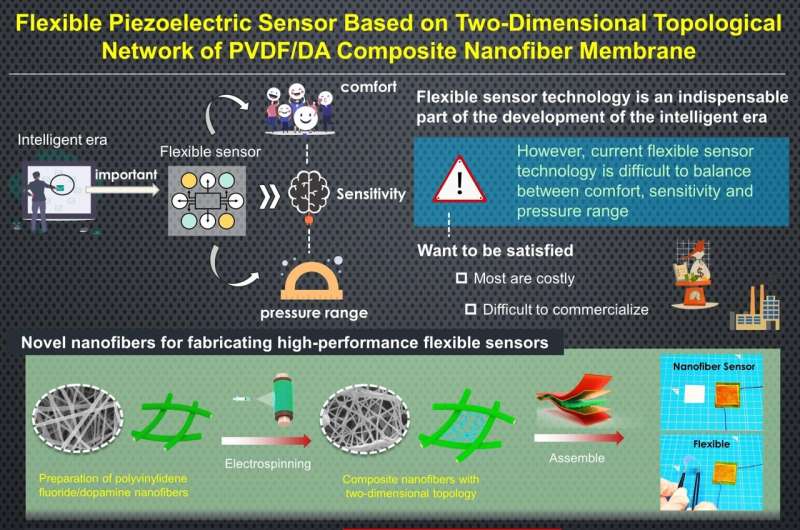This article has been reviewed according to Science X's editorial process and policies. Editors have highlighted the following attributes while ensuring the content's credibility:
fact-checked
trusted source
proofread
Study uses electrospun nanofibers to improve flexible piezoelectric sensors

Flexible piezoelectric sensors are essential to monitor the motions of both humans and humanoid robots. However, existing designs are either costly or have limited sensitivity.
In a recent study, researchers from Japan tackled these issues by developing a novel piezoelectric composite material made from electrospun polyvinylidene fluoride nanofibers combined with dopamine. Sensors made from this material showed significant performance and stability improvements at a low cost, promising advancements in medicine, health care, and robotics.
Their study, which was led by Distinguished Professor Ick Soo Kim in association with Junpeng Xiong, Ling Wang, Mayakrishnan Gopiraman, and Jian Shi, is published in Advanced Fiber Materials.
The world is accelerating rapidly towards the intelligent era—a stage in history marked by increased automation and interconnectivity by leveraging technologies such as artificial intelligence and robotics. As a sometimes-overlooked foundational requirement in this transformation, sensors represent an essential interface between humans, machines, and their environment.
However, now that robots are becoming more agile and wearable electronics are no longer confined to science fiction, traditional silicon-based sensors won't make the cut in many applications. Thus, flexible sensors, which provide better comfort and higher versatility, have become a very active area of study.
Piezoelectric sensors are particularly important in this regard, as they can convert mechanical stress and stretching into an electrical signal. Despite numerous promising approaches, there remains a lack of environmentally sustainable methods for mass-producing flexible, high-performance piezoelectric sensors at a low cost.
Against this backdrop, a research team from Shinshu University, Japan, decided to step up to the challenge and improve flexible piezoelectric sensor design using a well-established manufacturing technique: electrospinning.
The proposed flexible sensor design involves the stepwise electrospinning of a composite 2D nanofiber membrane. First, polyvinylidene fluoride (PVDF) nanofibers with diameters on the order of 200 nm are spun, forming a strong uniform network that acts as the base for the piezoelectric sensor.
Then, ultrafine PVDF nanofibers with diameters smaller than 35 nm are spun onto the preexisting base. These fibers become automatically interweaved between the gaps of the base network, creating a particular 2D topology.
After characterization via experiments, simulations, and theoretical analyses, the researchers found that the resulting composite PVDF network had enhanced beta crystal orientation.
By enhancing this polar phase, which is responsible for the piezoelectric effect observed in PVDF materials, the piezoelectric performance of the sensors was significantly improved. To increase the stability of the material further, the researchers introduced dopamine (DA) during the electrospinning process, which created a protective core–shell structure.
"Sensor fabricated from using PVDF/DA composite membranes exhibited superb performance, including a wide response range of 1.5–40 N, high sensitivity of 7.29 V/N to weak forces in the range of 0–4 N, and excellent operational durability," said Kim.
These exceptional qualities were demonstrated practically using wearable sensors to measure a wide variety of human movements and actions. More specifically, the proposed sensors, when worn by a human, could produce an easily distinguishable voltage response to natural motions and physiological signals. This included finger tapping, knee and elbow bending, foot stamping, and even speaking and wrist pulses.
Given the potential low-cost mass production of these piezoelectric sensors, combined with their use of environmentally friendly organic materials instead of harmful inorganics, this study could have important technological implications not only for health monitoring and diagnostics, but also robotics.
"Despite the current challenges, humanoid robots are poised to play an increasingly integral role in the very near future. For instance, the well-known Tesla robot 'Optimus' can already mimic human motions and walk like a human," added Kim.
"Considering high-tech sensors are currently being used to monitor robot motions, our proposed nanofiber-based superior piezoelectric sensors hold much potential not only for monitoring human movements, but also in the field of humanoid robotics."
To make the adoption of these sensors easier, the research team will be focusing on improving the material's electrical output properties so that flexible electronic components can be driven without the need for an external power source.
More information: Junpeng Xiong et al, Flexible Piezoelectric Sensor Based on Two-Dimensional Topological Network of PVDF/DA Composite Nanofiber Membrane, Advanced Fiber Materials (2024). DOI: 10.1007/s42765-024-00415-7
Provided by Shinshu University





















